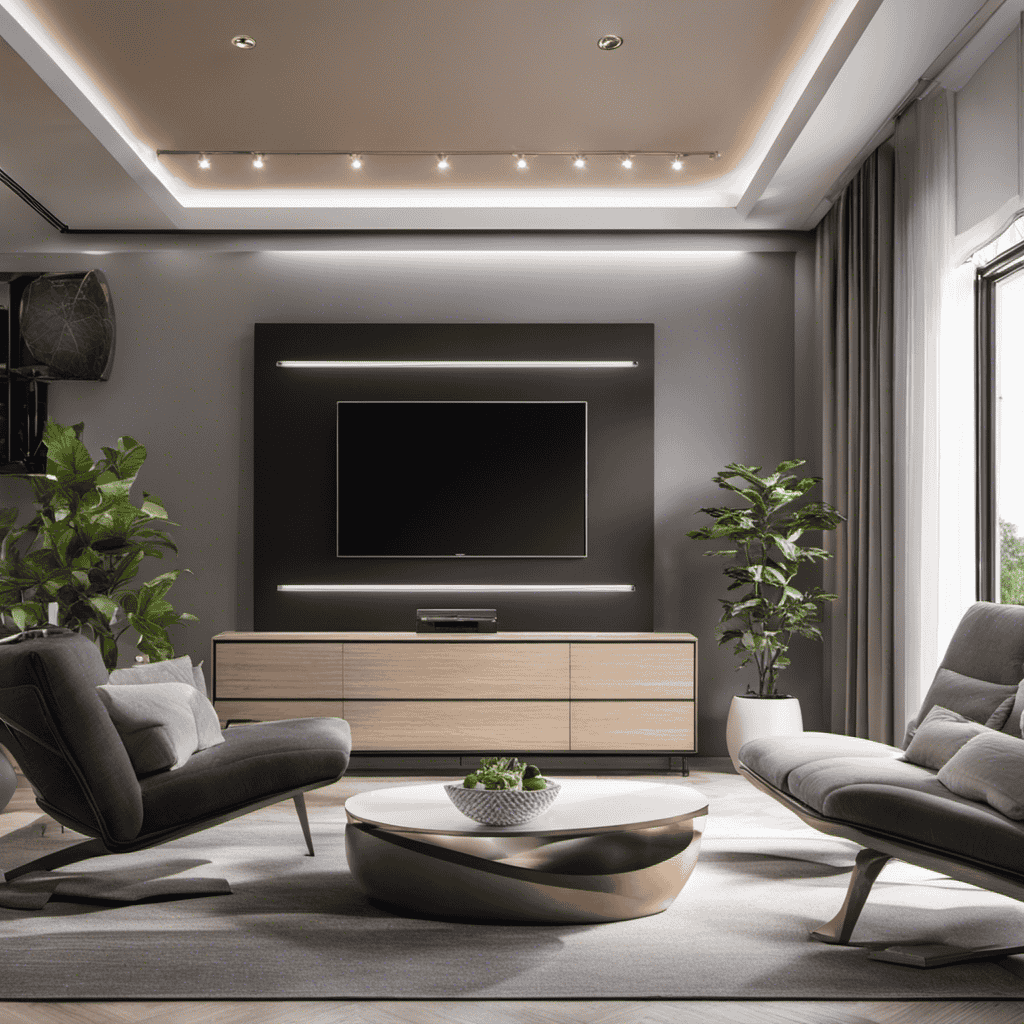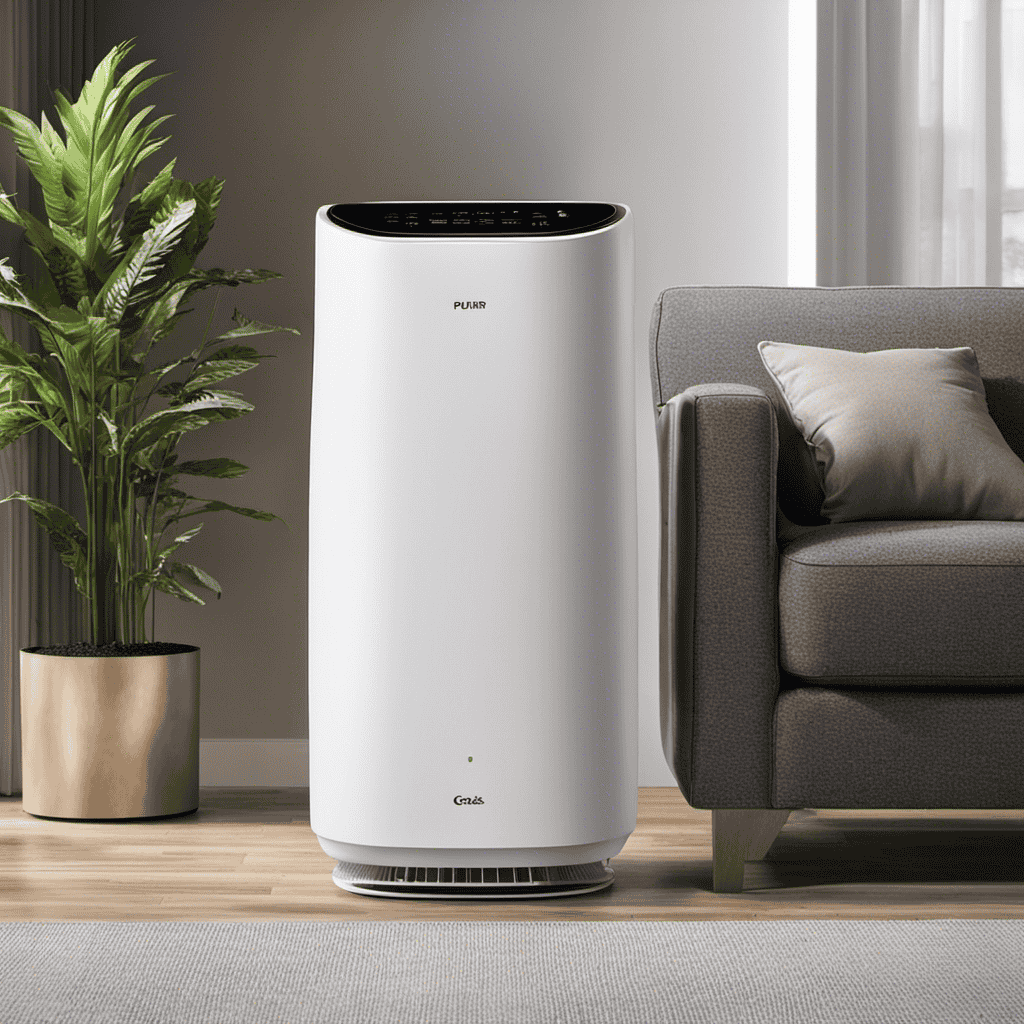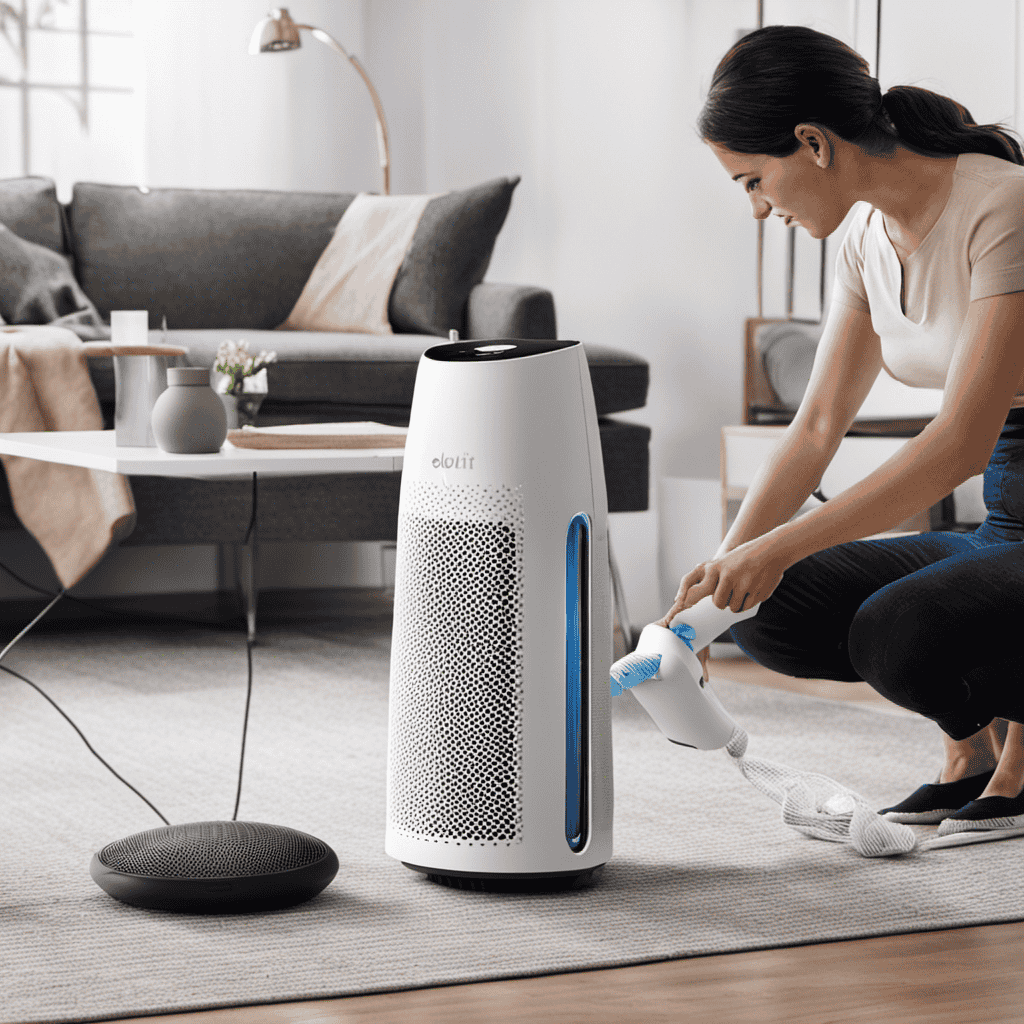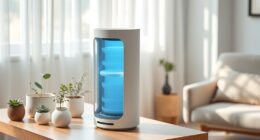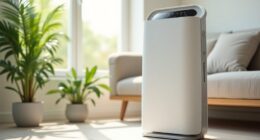I have always strongly believed that clean air is crucial for a healthy household. This is why I have chosen to impart my knowledge on mounting air purifiers on walls.
In this article, I’ll guide you through the process, from selecting the right bracket to fine-tuning the positioning. With these ideas, you’ll be able to optimize your air purifier’s effectiveness and save valuable floor space.
So, let’s dive in and discover the secrets to a well-mounted air purifier!
Key Takeaways
- Consider the weight and size of your air purifier when selecting a wall mounting bracket.
- Choose a bracket that can support the weight of your air purifier and check the specifications and weight capacity before purchasing.
- Determine the ideal placement for your air purifier by considering factors like room size, furniture placement, and air flow.
- Prepare the wall for mounting by clearing the area, using a level to determine placement, and locating studs for stability.
Selecting the Right Wall Mounting Bracket
When selecting the right wall mounting bracket, it’s important to consider the weight and size of your air purifier. There are various alternative bracket options available to suit different types of air purifiers. One tip for wall mounting securely is to choose a bracket that can support the weight of your air purifier. Make sure to check the specifications and weight capacity of the bracket before making a purchase.
Additionally, consider the size of your air purifier and ensure that the bracket is compatible with its dimensions. This will ensure a secure and stable mounting.
Now that you have selected the right bracket, let’s move on to determining the ideal placement for your air purifier.
Determining the Ideal Placement for Your Air Purifier
To find the best spot for your air cleaning device, consider factors like room size, furniture placement, and air flow. These elements can impact the effectiveness of your air purifier and ensure that it is placed in an optimal location. One important aspect to consider is the mounting height of the device. It is recommended to mount the air purifier at a height of around 6 to 8 feet from the floor. This allows for better air circulation and coverage in the room. However, if wall mounting is not an option for you, there are alternative placement options available. You can place the air purifier on a sturdy table or shelf, ensuring that it is positioned at a height that allows for proper air intake and distribution. Another option is to place the device on the floor, preferably in a corner or against a wall, to maximize air flow. Consider using the following table to help you determine the ideal placement for your air purifier:
| Placement Options | Pros | Cons |
|---|---|---|
| Wall Mounting | Saves space, better air circulation | Installation required, limited flexibility |
| Table/Shelf | Easy to move, convenient placement | Limited coverage, may take up space |
| Floor | Maximum air flow, versatile placement | May not be aesthetically pleasing, limited coverage |
Remember to take into account your specific room layout and personal preferences when deciding on the best placement for your air purifier.
Preparing the Wall for Mounting
Before you start preparing the wall for installation, make sure you have all the necessary tools and materials.
Preparing the surface is an important step to ensure a secure and stable mount for your air purifier. Begin by clearing the area of any obstructions or debris. Use a level to determine the ideal placement and mark the spot where you’ll install the wall mounting bracket.
Next, measure the distance between the bracket’s holes and transfer those measurements onto the wall. Use a stud finder to locate the studs, as they provide the strongest support for your air purifier. Once you have identified the studs, mark their positions on the wall. This will guide you in attaching the wall mounting bracket securely.
With the surface prepared, it’s time to move on to installing the wall mounting bracket.
Installing the Wall Mounting Bracket
Once you’ve located the studs and marked their positions on the wall, it’s time to attach the wall mounting bracket securely. This step is crucial to ensure that your air purifier stays in place and doesn’t fall off the wall.
There are a few different methods you can explore when it comes to installing the wall mounting bracket. One common method is to use screws and anchors to secure it to the wall. Another alternative method is to use heavy-duty adhesive tapes or Velcro strips. These can be great options if you don’t want to drill into your walls or if you’re renting and need a non-permanent solution. However, it’s important to choose a method that is appropriate for the weight and size of your air purifier.
When troubleshooting common issues during the installation of the wall mounting bracket, there are a few things to keep in mind. If the bracket seems unstable or wobbly, double-check that it is securely attached to the wall and that all screws or adhesive strips are properly applied. If the bracket is not level, use a level tool to adjust it before attaching the air purifier. Additionally, make sure to follow any specific instructions provided by the manufacturer for your particular model of air purifier.
Now that the wall mounting bracket is securely in place, it’s time to move on to the next step: attaching the air purifier to the wall mount.
Attaching the Air Purifier to the Wall Mount
When it comes to attaching your air purifier to the wall mount, there are a few key points to consider.
Firstly, you’ll want to explore the various mounting hardware options available to ensure a secure and stable installation.
Secondly, it’s important to identify the ideal placement locations in your home, taking into account factors such as air circulation and accessibility for maintenance.
Lastly, safety considerations should not be overlooked, including ensuring the proper weight-bearing capacity of the wall mount and taking precautions to prevent accidents or damage.
Mounting Hardware Options
There’s a variety of mounting hardware options available for securing your air purifier to the wall. Depending on the type and size of your air purifier, you can choose from the following options:
-
Wall brackets: These brackets are specifically designed to hold air purifiers securely to the wall. They usually come with adjustable arms to accommodate different sizes and models.
-
Mounting screws: If your air purifier has pre-drilled holes on the back, you can use mounting screws to attach it directly to the wall. Make sure to use the right size and length of screws for a secure installation.
-
Adhesive hooks: For lightweight air purifiers, adhesive hooks can be a convenient option. They are easy to install and remove without causing damage to the wall.
-
Wall-mounted shelves: If you prefer a more versatile option, wall-mounted shelves can be used to hold your air purifier. Just make sure the shelf is sturdy enough to support the weight.
When installing your air purifier, always follow the manufacturer’s instructions to ensure proper installation. Additionally, regular maintenance is essential to keep your air purifier working efficiently. Clean or replace the filters as recommended to maintain optimal performance.
Ideal Placement Locations
When it comes to wall mounting an air purifier, ideal placement locations are crucial for optimal performance and aesthetic considerations. The mounting height plays a significant role in the effectiveness of the air purifier. Generally, it is recommended to mount the air purifier at a height of about 6-8 feet from the floor. This height allows for better air circulation and coverage throughout the room.
Additionally, aesthetic considerations should also be taken into account when choosing the placement location. You want the air purifier to blend seamlessly with your existing decor and not be an eyesore. Placing it near a power outlet is essential for easy installation and accessibility.
To give you a better idea, here is a table outlining the recommended mounting heights and aesthetic considerations for wall-mounted air purifiers:
| Room Size | Mounting Height | Aesthetic Considerations |
|---|---|---|
| Small Room | 6-7 feet | Blend with decor |
| Medium Room | 7-8 feet | Discreet placement |
| Large Room | 8-9 feet | Concealed installation |
Safety Considerations
For optimal safety, it’s important to consider potential hazards and precautions when installing a wall-mounted air purifier. Wall mounting offers several benefits, including saving space and keeping the unit out of reach from children and pets. Here are some key safety considerations to keep in mind:
-
Securely mount the air purifier: Use sturdy brackets and ensure they are properly screwed into the wall to prevent the unit from falling.
-
Check the weight capacity: Make sure the wall can support the weight of the air purifier to avoid any structural damage.
-
Keep cords away from walkways: Tuck away any cords or wires to prevent tripping hazards.
-
Regular maintenance: Remember to clean or replace filters as recommended by the manufacturer to ensure optimal performance.
Fine-tuning the Positioning and Angling of the Air Purifier
To optimize the performance, try angling the air purifier slightly downwards for better air circulation. When positioning your air purifier, it is important to consider the layout of the room and the airflow patterns. Placing the air purifier in a central location can help ensure that the clean air is distributed evenly throughout the room. Additionally, avoid placing the air purifier near any obstacles or walls that may obstruct the airflow.
To give you a better understanding of the positioning techniques, here is a table that illustrates the optimal placement for an air purifier:
| Positioning Technique | Description |
|---|---|
| Central Placement | Place the air purifier in the center of the room for even distribution of clean air. |
| Avoid Obstacles | Keep the air purifier away from walls, furniture, or any other objects that may block the airflow. |
| Angling | Angle the air purifier slightly downwards to ensure better air circulation. |
Frequently Asked Questions
How Do I Clean and Maintain My Wall-Mounted Air Purifier?
To clean and maintain my wall-mounted air purifier, I follow these tips: regularly clean the filters, wipe down the exterior with a damp cloth, and check for any signs of damage. If there are any issues, I troubleshoot them by referring to the user manual.
Can I Mount the Air Purifier on Any Type of Wall Surface?
Yes, you can mount the air purifier on any type of wall surface, including brick or concrete. I’ve done it before and it’s a straightforward process. Just make sure to use the appropriate mounting hardware for your specific wall material.
Is It Possible to Adjust the Height of the Air Purifier Once It’s Mounted?
Yes, it is possible to adjust the height of the air purifier once it’s mounted. During the installation process, make sure to choose a mounting bracket that allows for height adjustment to suit your needs.
What Are the Potential Risks or Dangers of Wall-Mounting an Air Purifier?
When it comes to wall-mounting an air purifier, there are potential dangers and safety concerns to consider. These include improper installation leading to falling or damage, electrical risks, and reduced effectiveness if not placed correctly.
Are There Any Additional Accessories or Equipment Needed for Wall Mounting an Air Purifier?
Accessories needed for wall mounting an air purifier include brackets, screws, and a level for proper installation. Additionally, equipment required may include a drill, screwdriver, and stud finder to ensure secure attachment to the wall.
Conclusion
In conclusion, wall mounting an air purifier is a practical and space-saving solution for improving indoor air quality. By selecting the right wall mounting bracket and determining the ideal placement, you can ensure maximum efficiency and effectiveness.
It is interesting to note that according to a recent study, wall-mounted air purifiers have been found to reduce airborne allergens by up to 99%. Just imagine the fresh and clean air you can enjoy in your home with this simple installation.
So, don’t hesitate to give it a try and experience the benefits for yourself.
